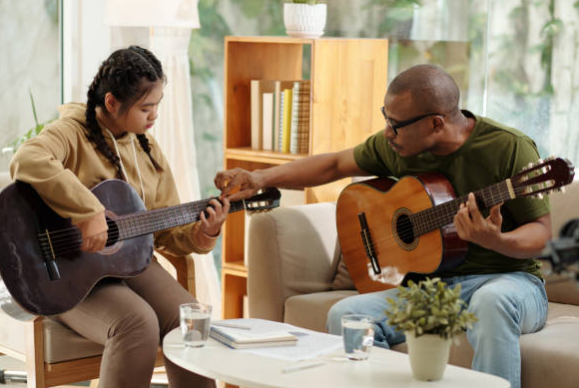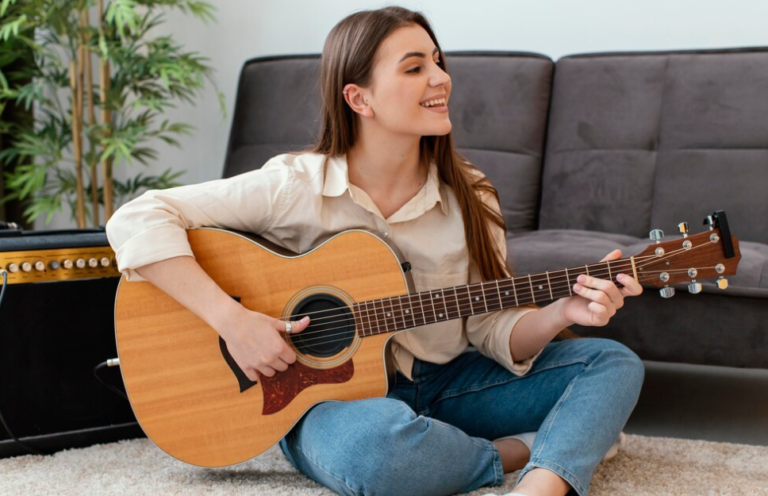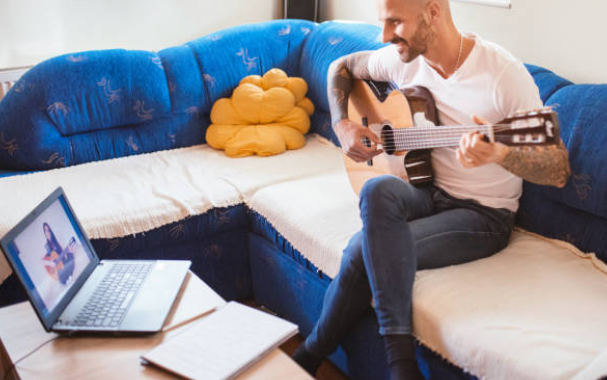All You Need To Know About How To Play The B Minor Pentatonic Scale on Guitar

The B Minor Pentatonic Scale is a five-note scale that is both easy to learn and extremely useful across a variety of musical styles, from rock and blues to jazz and pop. This scale not only enhances your soloing capabilities but also gives you a foundation for improvisation and melody creation.
In this blog post, we’ll explore how to play the B Minor Pentatonic Scale on the guitar, offering tips for memorization, practice techniques, and application.
Understanding The B Minor Pentatonic Scale
The pentatonic scale consists of five notes per octave. In the case of the B Minor Pentatonic, these notes are B, D, E, F#, and A. This scale can be thought of as a stripped-down version of the full B Minor scale, removing any potentially dissonant half-steps to provide a more consonant sound that’s ideal for soloing.
Fretboard Positions
The B Minor Pentatonic can be played in various positions and patterns across the fretboard, but we’ll start with the most common and versatile pattern: the first position.
Open Position
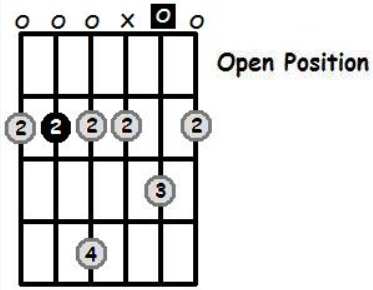
- 6th String (E string): Do not play this string, as indicated by the “X” above the string on the diagram.
- 5th String (A string): Place your middle finger on the second fret to play B.
- 4th String (D string): Place your index finger on the second fret to play E.
- 3rd String (G string): Play the open G string to play G. Then, place your middle finger on the second fret to play A.
- 2nd String (B string): Play the open B string to play B.
- 1st String (E string): Play the open E string to play E, and place your middle finger on the second fret to play F#.
These notes create a box pattern that is easy to remember and visually identify on the fretboard.
2nd Position
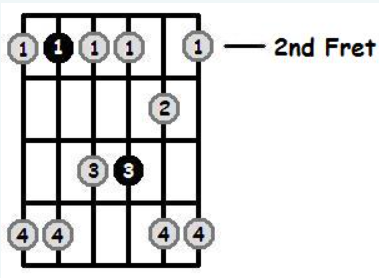
- 6th String (E string): Place your pinky finger on the 4th fret to play the note F#.
- 5th String (A string): Place your index finger on the 2nd fret to play the note B. Then use your 4th finger (pinky) on the 4th fret to play the note D.
- 4th String (D string): Place your index finger on the 2nd fret to play the note E. Use your 3rd finger (ring) on the 4th fret to play the note F#.
- 3rd String (G string): Place your index finger on the 2nd fret to play the note A. Use your 3rd finger (ring) on the 4th fret to play the note B.
- 2nd String (B string): Place your index finger on the 2nd fret to play the note D. Use your 2nd finger (middle) on the 3rd fret to play the note E.
- 1st String (E string): Place your index finger on the 2nd fret to play the note F#.
- Use your index finger on the 4th fret to play the note A.
4th Position

- 6th String (E string): Place your pinky finger on the 7th fret to play the note B.
- 5th String (A string): Place your index finger on the 4th fret to play the note D. Then, use your 2nd finger (middle) on the 5th fret to play the note E.
- 4th String (D string): Place your index finger on the 4th fret to play the note F#. Then, use your 4th finger (pinky) on the 7th fret to play the note A.
- 3rd String (G string): Place your index finger on the 4th fret to play the note B. Then, use your 4th finger (pinky) on the 7th fret to play the note D.
- 2nd String (B string): Place your index finger on the 4th fret to play the note E. Then, use your 2nd finger (middle) on the 5th fret to play the note F#.
- 1st String (E string): Place your index finger on the 4th fret to play the note A. Then, use your 4th finger (pinky) on the 7th fret to play note B.
Practicing The Scale
- Memorization: Begin by memorizing the fret and string of each note in the scale. Say the notes out loud as you play them to reinforce your memory.
- Use a Metronome: Start slowly and use a metronome to keep your timing consistent. Gradually increase the speed as you become more comfortable.
- Play Backwards and Forwards: Practice playing the scale forwards and backward. This builds your familiarity with the scale and improves your finger agility.
- Skip Strings: Once you’re comfortable, skip strings to make your playing sound more interesting and challenge your technical ability.
Applying the Scale
To use the B Minor Pentatonic effectively in solos and improvisation:
- Learn Licks: Learn common licks and phrases based on the pentatonic scale. Many famous guitar solos are pentatonic-based, providing excellent examples.
- Experiment with Rhythms: Don’t just play the notes in even succession. Mix up the rhythms to create interesting solos.
- Bend and Slide: Use techniques like bending and sliding to express emotion and add variety to your playing.
The B Minor Pentatonic is a gateway to expressive guitar playing. It’s not just about playing notes in sequence; it’s about making music that feels good. Spend time with this scale, integrate it into your daily practice, and use it as a tool to explore your musical voice.
By starting with this foundational scale, you can build your confidence and creativity on the guitar, paving the way for more complex musical endeavors.
If you’re interested in learning an instrument, at Real Brave, we offer an incredible experience like no other place in music lessons for kids and adults by guiding them from the beginning stages of getting to know an instrument all the way through performing for family and friends on stage. Our instructors come from all over the world, bringing extensive experience on a wide range of instruments. Click below and book a free lesson with us!
Author: Daniel Powers Jr, the founder of Real Brave™, serves as the chief inspiration to thousands of students in the Real Brave music instruction program. He’s also the visionary behind PracticePad™, an online platform for live one-on-one online music lessons, lesson tracking, and scheduling. Beyond his entrepreneurial pursuits, Daniel leads a non-profit organization that provides formerly homeless children with access to music education, making a profound impact on their lives. His unwavering dedication to music, innovation, and education continues to inspire individuals to reach their fullest potential while creating positive change in communities. Follow Real Brave on all the socials:
youtube.com/@realbraveinc
twitter.com/realbraveinc
https://www.tiktok.com/@realbraveinc
instagram.com/realbraveaudio
facebook.com/realbraveinc


